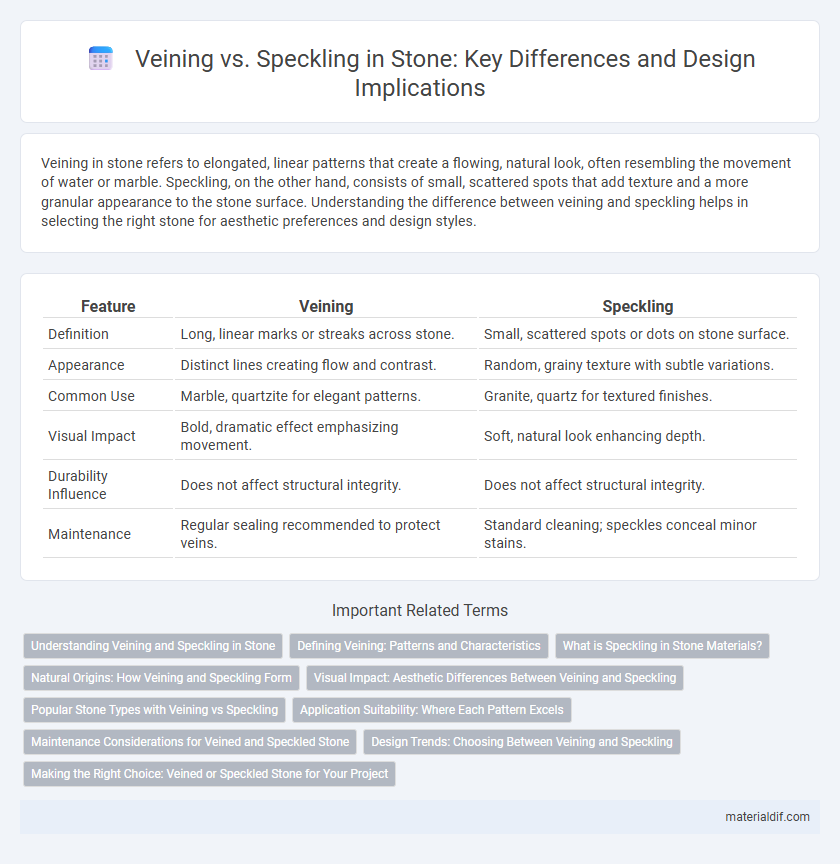Veining in stone refers to elongated, linear patterns that create a flowing, natural look, often resembling the movement of water or marble. Speckling, on the other hand, consists of small, scattered spots that add texture and a more granular appearance to the stone surface. Understanding the difference between veining and speckling helps in selecting the right stone for aesthetic preferences and design styles.
Table of Comparison
| Feature | Veining | Speckling |
|---|---|---|
| Definition | Long, linear marks or streaks across stone. | Small, scattered spots or dots on stone surface. |
| Appearance | Distinct lines creating flow and contrast. | Random, grainy texture with subtle variations. |
| Common Use | Marble, quartzite for elegant patterns. | Granite, quartz for textured finishes. |
| Visual Impact | Bold, dramatic effect emphasizing movement. | Soft, natural look enhancing depth. |
| Durability Influence | Does not affect structural integrity. | Does not affect structural integrity. |
| Maintenance | Regular sealing recommended to protect veins. | Standard cleaning; speckles conceal minor stains. |
Understanding Veining and Speckling in Stone
Veining in stone refers to the natural, linear patterns created by mineral deposits, often appearing as flowing lines or streaks that enhance the stone's visual depth and uniqueness. Speckling consists of small, scattered mineral spots or grains dispersed throughout the stone, contributing to a textured and granular appearance. Recognizing the difference between veining and speckling helps in selecting stone surfaces that best suit aesthetic preferences and design requirements.
Defining Veining: Patterns and Characteristics
Veining in stone refers to distinct, often linear patterns created by mineral deposits that contrast with the base color, offering a sense of movement and depth. These veins can vary in thickness, color, and intensity, typically appearing in materials like marble, quartzite, and granite. Veining patterns are sought after for their ability to add elegance and uniqueness to countertops, flooring, and other architectural elements.
What is Speckling in Stone Materials?
Speckling in stone materials refers to the presence of small, distinct spots or dots of mineral impurities scattered throughout the surface, creating a textured and varied appearance. These speckles result from naturally occurring mineral deposits such as quartz, mica, or feldspar embedded in the stone during its formation. Unlike veining, which forms linear patterns, speckling offers a more randomized, granular aesthetic commonly found in granite and quartzite.
Natural Origins: How Veining and Speckling Form
Veining in natural stone forms as mineral-rich fluids permeate cracks and fissures, solidifying over time to create distinct linear patterns. Speckling occurs when mineral deposits crystallize unevenly within the stone matrix, resulting in scattered, irregular spots. Both veining and speckling reveal the geological processes and mineral compositions unique to the stone's natural formation.
Visual Impact: Aesthetic Differences Between Veining and Speckling
Veining in stone creates bold, linear patterns that draw the eye and add a sense of movement and elegance, often resembling natural marble. Speckling consists of small, scattered dots or flecks that produce a more subtle, textured appearance, contributing to a uniform and understated visual effect. The contrast between veining and speckling lies in their aesthetic impact, with veining offering dramatic, flowing lines and speckling providing gentle, granular dimension.
Popular Stone Types with Veining vs Speckling
Marble and quartzite are popular stone types known for their distinct veining, characterized by flowing, linear patterns that create dramatic visual effects. Granite and soapstone commonly exhibit speckling, with scattered flecks and small mineral deposits that provide a more uniform and textured appearance. Understanding these natural pattern variations helps in selecting the ideal stone for countertops, flooring, or decorative accents based on aesthetic preferences and design goals.
Application Suitability: Where Each Pattern Excels
Veining in stone is ideal for applications requiring continuous, flowing patterns such as countertops and feature walls, enhancing elegance and visual movement. Speckling excels in areas demanding subtle texture and uniformity, including flooring and backsplashes, providing a balanced and consistent appearance. Choosing between veining and speckling depends on the desired visual impact and functional requirements of the space.
Maintenance Considerations for Veined and Speckled Stone
Veined stone requires careful maintenance to prevent dirt and residue accumulation along the veins, which can highlight imperfections and cause discoloration over time. Speckled stone tends to be more forgiving with wear and staining, as its pattern naturally hides minor blemishes and requires less frequent deep cleaning. Both types benefit from regular sealing, but veined stone often demands more meticulous upkeep to preserve its distinct appearance.
Design Trends: Choosing Between Veining and Speckling
Veining in stone offers bold, linear patterns that create dramatic focal points, often favored in modern and luxurious interior designs. Speckling provides a subtler, more uniform texture ideal for minimalist and natural aesthetics. Designers select veining for statement surfaces and speckling for understated elegance, aligning with current trends in kitchen countertops and bathroom vanities.
Making the Right Choice: Veined or Speckled Stone for Your Project
Veined stone features bold, linear patterns created by mineral deposits, lending a dramatic and elegant look ideal for statement surfaces like countertops or feature walls. Speckled stone displays a more uniform distribution of small mineral grains, offering a subtle, versatile appearance that works well in high-traffic areas requiring durability and camouflage of wear. Choosing between veining and speckling depends on the project's aesthetic goals and functionality, as veined stone enhances visual impact while speckled stone provides timeless resilience.
Veining vs Speckling Infographic

 materialdif.com
materialdif.com